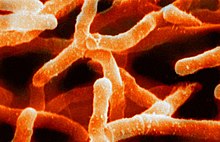Terrabacteria is a taxon containing approximately two-thirds (6,157 sp.) of prokaryote species, including those in the gram positive phyla (Actinobacteria and Firmicutes) as well as the phyla Cyanobacteria, Chloroflexi, and Deinococcus-Thermus.[1][2]
It derives its name (terra = "land") from the evolutionary pressures of life on land. Terrabacteria possess important adaptations such as resistance to environmental hazards (e.g., desiccation, ultraviolet radiation, and high salinity) and oxygenic photosynthesis. Also, the unique properties of the cell wall in gram-positive taxa, which likely evolved in response to terrestrial conditions, have contributed toward pathogenicity in many species.[2] These results now leave open the possibility that terrestrial adaptations may have played a larger role in prokaryote evolution than currently understood.[1][2]
Terrabacteria was proposed in 2004 for Actinobacteria, Cyanobacteria, and Deinococccus-Thermus [1] and was expanded later to include Firmicutes and Chloroflexi.[2] Other phylogenetic analyses [3] have supported the close relationships of these phyla. Most species of prokaryotes not placed in Terrabacteria were assigned to the taxon Hydrobacteria [2] (3,203 sp.), in reference to the moist environment inferred for the common ancestor of those species. Terrabacteria and Hydrobacteria were inferred to have diverged approximately 3 billion years ago, suggesting that land (continents) had been colonized by prokaryotes at that time.[2]Together, Terrabacteria and Hydrobacteria form a large group containing 99% (9,360 sp.) of all Eubacteria known by 2009, and placed in the taxon Selabacteria, in allusion to their phototrophic abilities (selas = light).[4]
Terrabacteria should not be confused with the recently described taxon "Glidobacteria",[5] which includes only some members of Terrabacteria but excludes Firmicutes and Actinobacteria, and is not supported by molecular phylogenetic data.[2]
Recent molecular analyzes have found roughly the following relationships including other phyla, whose relationships were uncertain.[6][7][8][9][10][11]
| Terrabacteria |
| ||||||||||||||||||||||||||||||||||||||||||||||||||||||||||||||||||||||||||||||||||||||||||||||||||||||||||||||||||||||||||||||||||||||||||||||||
On the other hand, Coleman et al (2020) named the clade composed of Thermotogae, Deinococcus-Thermus, Synergistetes and related as DST and furthermore the analysis suggests that ultra-small bacteria (CPR group) may belong to Terrabacteria being more closely related to Chloroflexi. According to this study the phylum Aquificae sometimes included belongs to Gracilicutes and that the phylum Fusobacteria can belong to both Terrabacteria and Gracilicutes. The result was the following:[12]
| Terrabacteria | |
|---|---|
 | |
| Scanning electron micrograph of Actinomyces israelii (Actinobacteria) | |
| Scientific classification | |
| Domain: | |
| (unranked): | Terrabacteria Battistuzzi et al., 2004, Battistuzzi & Hedges, 2009 |
| Phyla | |
| Synonyms | |
| |
https://en.wikipedia.org/wiki/Terrabacteria
above.
No comments:
Post a Comment